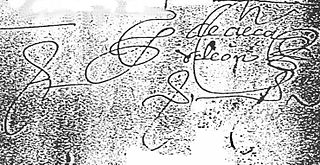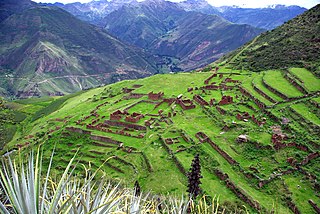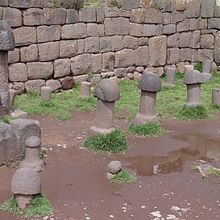
Sinchi Roca, Sinchi Rocca, Cinchi Roca, Sinchi Ruq'a or Sinchi Ruq'a Inka was the second Sapa Inca of the Kingdom of Cusco and a member of the Hurin dynasty.

Sacsayhuamán, which can be spelled many different ways, is a citadel on the northern outskirts of the city of Cusco, Peru, the historic capital of the Inca Empire.

The Chachapoyas, also called the "Warriors of the Clouds", was a culture of the Andes living in the cloud forests of the southern part of the Department of Amazonas of present-day Peru. The Inca Empire conquered their civilization shortly before the Spanish conquest in the 16th century. At the time of the arrival of the conquistadors, the Chachapoyas were one of the many nations ruled by the Incas, although their incorporation had been difficult due to their constant resistance to Inca troops.

Inca architecture is the most significant pre-Columbian architecture in South America. The Incas inherited an architectural legacy from Tiwanaku, founded in the 2nd century B.C.E. in present-day Bolivia. A core characteristic of the architectural style was to use the topography and existing materials of the land as part of the design. The capital of the Inca empire, Cuzco, still contains many fine examples of Inca architecture, although many walls of Inca masonry have been incorporated into Spanish Colonial structures. The famous royal estate of Machu Picchu is a surviving example of Inca architecture. Other significant sites include Sacsayhuamán and Ollantaytambo. The Incas also developed an extensive road system spanning most of the western length of the continent and placed their distinctive architecture along the way, thereby visually asserting their imperial rule along the frontier.

Pedro Cieza de León was a Spanish conquistador and chronicler of Peru and Popayán. He is known primarily for his history and description of Peru, Crónicas del Perú. He wrote this book in four parts, but only the first was published during his lifetime; the remaining sections were not published until the 19th and 20th centuries.

Coricancha, Koricancha, Qoricancha or Qorikancha was the most important temple in the Inca Empire. It is located in Cusco, Peru, which was the capital of the empire.

The Inca Civil War, also known as the Inca Dynastic War, the Inca War of Succession, or, sometimes, the War of the Two Brothers, was fought between half-brothers Huáscar and Atahualpa, sons of Huayna Capac, over succession to the throne of the Inca Empire. The war followed Huayna Capac's death in 1527.
Tumebamba, Tomebamba or Tumipampa was a former main regional city in the Inca Empire. Tumebamba was chosen by the Emperor Huayna Capac to be the Inca northern capital. The city was largely destroyed during the civil war between Huáscar and Atahualpa shortly before the arrival of the Spanish conquistadors in 1532. The Spanish city of Cuenca, Ecuador was built on the site of Tumebamba although a portion of the Inca city is preserved at the archaeological sites of Pumapunku and Todos Santos.

A tambo was an Incan structure built for administrative and military purposes. Found along the extensive roads, tambos typically contained supplies, served as lodging for itinerant state personnel, and were depositories of quipu-based accounting records. Individuals from nearby communities within the Inca empire were conscripted to maintain and serve in the tambos, as part of the mit'a labor system. Tambos were spaced along Incan roads, generally about one day's travel apart.
La Canela, the Valley of Cinnamon, is a legendary location in South America. As with El Dorado, its legend grew out of expectations aroused by the voyage of Columbus. He had demonstrated to the satisfaction of his backers that gold and spices would be found as a result of his Atlantic crossing; since he himself found little of these commodities, the search on the American mainland continued.

Chucuito District is one of the districts of the Puno Province in the Puno Region in Peru.

Chucuito Province is a province of the Puno Region in Peru. The capital of the province is the city of Juli.
The Incan aqueducts refer to any of a series of aqueducts built by the Inca people. The Inca built such structures to increase arable land and provide drinking water and baths to the population. Due to water scarcity in the Andean region, advanced water management was necessary for the Inca to thrive and expand along much of the coast of Peru. Such structures, some of which survive today, show the advanced hydraulic and civil engineering capabilities of the Inca.
Mala District is one of sixteen districts of the province Cañete in Peru. It limits on the north with San Antonio District and Santa Cruz de Flores District that separates them the Mala river. To the south-east, the Coayllo District.
Guaqui is a railhead and port in Bolivia on Lake Titicaca. A ferry connects with the Peruvian railhead and port on Puno. It served as location of Inca ruins prior to the arrival of the Spanish. The towns current church sites on what was the ancient ruins.
Ayaviri or Ayawiri (Aymara) is a town in Southern Peru, capital of the province Melgar in the region Puno. According to the 2007 Peruvian census, Ayaviri has a population of 22,667 people. Local festivities of note include the Festividad de Calendaria on January 24 and the Aniversario de la Provincia on October 25.
Ukumari was an Inca prince and general supporting the cause of Atahualpa in the Inca Civil War.
Pedro de Candia was a Greek explorer and cartographer at the service of the Kingdom of Spain, an officer of the Royal Spanish Navy that under the Spanish Crown became a Conquistador, Grandee of Spain, Commander of the Royal Spanish Fleet of the Southern Sea, Colonial Ordinance of Cusco, and then Mayor of Lima between 1534 and 1535. Specialized in the use of firearms and artillery, he was one of the earliers explorers of Panama and the Pacific coastline of Colombia, and finally participated in the conquest of Peru. He was killed in the Battle of Chupas, (Peru), on 16 September 1542, by Diego de Almagro II.

Huchuy Qosqo,, is an Incan archaeological site north of Cuzco, Peru. Its name is Quechua for "Little Cuzco." It lies at an elevation of 3,650 meters, overlooking the Sacred Valley and 3 kilometres (1.9 mi) west and above the town of Lamay at an elevation of 2,920 metres (9,580 ft). The site received its name in the 20th century; previously it had been known as Caquia Xaquixaguana, or Kakya Qawani.

Chucuito is a village in the Chucuito District, Puno Province, Peru. It is 18 kilometres (11 mi) from the city of Puno. It sits at 3,875 metres (12,713 ft) above sea level. The population is 7,913.













